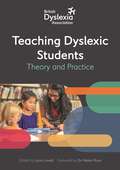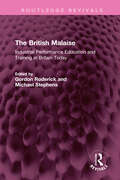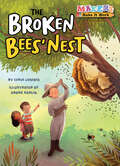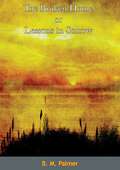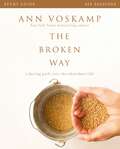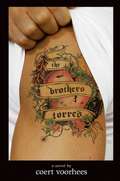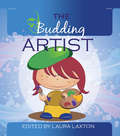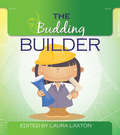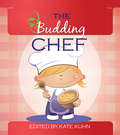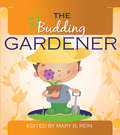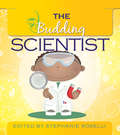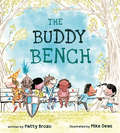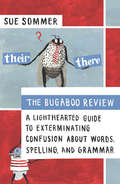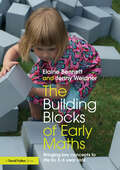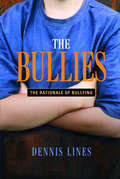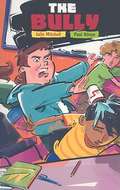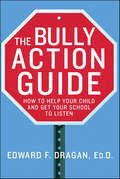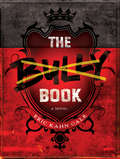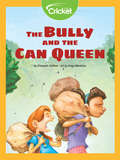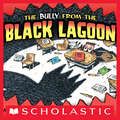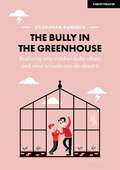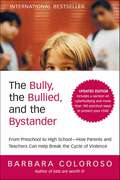- Table View
- List View
The British Dyslexia Association - Teaching Dyslexic Students: Theory and Practice
by British Dyslexia AssociationThis BDA developed guide assists you in supporting children and students with dyslexia and specific learning difficulties through their education. Designed specifically for candidates on Level 5 diploma courses in dyslexia and specific learning difficulties, this hands-on guide is the perfect training companion for those wanting to know more about dyslexia and how to support individuals with dyslexia.As an authoritative, entry-level resource covering both theory and practice, the methods, resources, and expert contributors in this book empower your learning as an educator towards better self-understanding, confidence and how to better support students in specialist and classroom settings.
The British Malaise: Industrial Performance Education and Training in Britain Today (Routledge Revivals)
by Michael Stephens Gordon RoderickThis series of edited papers, originally published in 1982, examines Britain’s industrial and commercial performance in the nineteenth and twentieth centuries against the background of the development of state education. The performance of certain key nineteenth-century manufacturing industries is analysed and the reasons for their relative decline in the face of foreign competition is assessed. Further, the title examines the present and future of British industry contending that the British Malaise is a disease of industrial dyslexia, the inability to match the industrial problems of the real world with variable industrial objectives and performance.
The Broken Bees' Nest (Makers Make It Work)
by Lydia LukidisTying into the popular Makers Movement, Makers Make it Work is a series of fun easy-to-read stories that focus on problem-solving and hands-on action. With bright, eye-catching art and explanatory sidebars with additional information on the topic, these books show kids how to use their hands, their heads, their creativity, and their problem-solving skills to overcome every challenge facing them. Arun and Keya find the perfect tree for a tree house. Too bad it comes with a battered bees' nest! These bees need a new home—right away! With the Makers Make It Work series, any kid can be a Maker! Each book also includes an activity for young makers to try themselves. (Topic: Beekeeping).
The Broken Compass
by Keith Robinson Angel L. HarrisIt seems like common sense that children do better when parents are actively involved in their schooling. But how well does the evidence stack up? The Broken Compass puts this question to the test in the most thorough scientific investigation to date of how parents across socioeconomic and ethnic groups contribute to the academic performance of K-12 children. The study's surprising discovery is that no clear connection exists between parental involvement and improved student performance. Keith Robinson and Angel Harris assessed over sixty measures of parental participation, at home and in school. Some of the associations they found between socioeconomic status and educational involvement were consistent with past studies. Yet other results ran contrary to previous research and popular perceptions. It is not the case that Hispanic and African American parents are less concerned with education than other ethnic groups--or that "tiger parenting" among Asian Americans gets the desired results. In fact, many low-income parents across a wide spectrum want to be involved in their children's school lives, but they often receive little support from the school system. And for immigrant families, language barriers only worsen the problem. While Robinson and Harris do not wish to discourage parents' interest, they believe that the time has come to seriously reconsider whether greater parental involvement can make much of a dent in the basic problems facing their children's education today. This provocative study challenges some of our most cherished beliefs about the role of family in educational success.
The Broken Home or Lessons in Sorrow
by B. M. PalmerB. M. Palmer relates a series of personal experiences bereaving a deceased child; how to come to terms with the loss, honor the memory of the departed, and rediscover meaning, hope and value in life.The loss of one's son or daughter is among the most soul-shattering experiences a parent can go through. Witnessing a loved one's decline as illness takes hold, and having to make the experience of dying comfortable for them while dealing with the emotional impact, is a process defined by anguish and difficulty. The author lived at a time when child mortality was higher than in the modern day; experiencing loss successive times, it is only with sheer strength of will that the author was able to continue living.Writing at the end of the 19th century, Palmer's thesis is partially rooted in the values and precepts of Christianity rather than modern psychological and therapeutic approaches. However, the practical advice and philosophical reflections, plus the expressive verses, carry a certain spiritual gravitas that is useful yet uncommon in modern grief counseling. The Broken Home thus remains a unique, worthy and poignant read, having resulted from the experience of multiple family tragedies.-Print ed.
The Broken Way Study Guide: A Daring Path into the Abundant Life
by Ann VoskampIn this six-session video Bible study (DVD/digital video sold separately), New York Times bestselling author Ann Voskamp takes us on a personal journey along the broken way. The broken way beckons you into more time, more meaning, more authentic relationships. There’s a way, especially when things aren’t shaping up quite like you imagined, that makes life take the shape of more—more abundance, more intimacy, more God.Ann Voskamp asks the following questions not one of us can afford to ignore:How do you live your one broken life?What does it mean to live cruciform and learn to receive?What do you do if you really want to know abundant wholeness—before it’s too late?There’s a way of honest, transformative power. Dare to take the broken way—to abundance.Sessions include:How Do We Live This One Broken Life?Living CruciformLearning to ReceiveReal KoinoniaEmbracing InconvenienceWho We ServeDesigned for use with The Broken Way Video Study 9780310820741 (sold separately).
The Brothers Torres
by Coert VoorheesFrankie Towers has always looked up to his older brother, Steve, and with good reason. Steve is a popular senior who always gets what he wants: girls, a soccer scholarship, and -- lately -- street cred. Frankie, on the other hand, spends his time shooting off fireworks with his best friend Zach, working at his parents' restaurant, and obsessing about his longtime crush, Rebecca Sanchez. Frankie has reservations about Steve's crusade to win the respect of the local cholos. He doesn't think about them, though, until he gets into a fist fight John Dalton -- the richest, preppiest kid in his New Mexican high school, and longtime nemesis of Steve. After the fight, Steve takes Frankie under his wing -- and Frankie's social currency begins to rise. The cholos who used to ignore him start to recognize him; he even lands a date to Homecoming with Rebecca. The situation with Dalton continues to simmer, and after another incident Steve is bent on retaliating. Frankie starts to think that his brother is taking this respect thing too far. He may have to choose between respecting his brother and respecting himself.
The Budding Artist
by Laura LaxtonCurious kids will delight in the wonder of the creative process with the fifty art-inspiring activities in The Budding Artist! With great ways for you and your budding artist to create beautiful memories together, this book shows parents and kids how to paint with bubbles, create glue webs, make a blooming tablecloth, and construct homemade paper valentines.Perfect for ages three to six, this fun-filled introduction to arts and crafts features easy-to-follow instructions and easy-to-find materials that will help you and your child have as much fun creating art as viewing the finished product!
The Budding Builder
by Laura LaxtonCurious kids will be inspired by the endless possibilities of the fifty fun-filled building activities in The Budding Builder! With great ways for you and your child to take ideas from their limitless imaginations and to fashion them into reality, this book shows parents and kids how to create a fairytale cottage, make a marker organizer, carefully construct a toothpick sculpture, and build a bird feeder.Perfect for kids ages three to six, this fun-filled introduction to architecture features easy-to-follow instructions and easy-to-find materials that will help your child develop many important life skills, from planning and estimating to counting and measuring. So enjoy the process, and be amazed at what you and your child can create together!
The Budding Chef
by Kate KuhnCurious kids will delight in the 50 fun-filled recipes in The Budding Chef! Full of great ways for parents and their budding chefs to have fun together, this introduction to cooking is brimming with kitchen adventures and is perfect for kids aged 3 to 6. The easy-to-follow instructions and easy-to-find ingredients helps parents share their love of cooking in kid-friendly ways while creating special moments that they--and their child--will cherish forever. With a cup of wonder, a teaspoon of laughter, and a scoop of fun, these recipes bring parents and children together to share magical moments!
The Budding Gardener
by Mary ReinCurious kids will discover their green thumbs with the fun-filled gardening activities in The Budding Gardener! With great ways for parents and their budding gardeners to create memories together, this book shows parents and kids how to plant a seed and watch it grow, create a garden marker, make a spider web out of sweet pea seeds and bamboo, and beautify the garden with a stone path or rock tower. Perfect for kids aged 3 to 6, this kid-friendly introduction to gardening features easy-to-follow instructions and easy-to-find materials that will help parents cultivate a love of the outdoors with their child in imaginative, new ways. With a little dirt, some water, and a few tools, these activities will bring parents and children together to share magical outdoor moments!
The Budding Scientist
by Stephanie RoselliCurious kids will delight in the joy of scientific discovery through the fifty fun activities in The Budding Scientist! This book is filled with great ways for you and your child to learn about how our world works. Create memories together as you make invisible ink, explore ice crystals, and investigate magnets.Perfect for children ages three to six, this fun-filled introduction to science features easy-to-follow instructions and easy-to-find materials that will help you satisfy your child's natural curiosity.
The Buddy Bench
by Patty BrozoHaving seen what being left out is like, children become agents of change, convincing their teacher to let them build a buddy bench. A school playground can be a solitary place for a kid without playmates; in one survey, 80 percent of 8- to 10-year-old respondents described being lonely at some point during a school day. Patty Brozo’s cast of kids brings a playground to raucous life, and Mike Deas’s illustrations invest their games with imaginary planes to fly, dragons to tame, and elephants to ride. And these kids match their imaginations with empathy, identifying and swooping up the lonely among them. Buddy benches are appearing in schoolyards around the country. Introduced from Germany in 2014, the concept is simple: When a child sits on the bench, it’s a signal to other kids to ask him or her to play.
The Bugaboo Review
by Sue SommerFor years, high school English teacher Sue Sommer has given her students a photocopied edition of The Bugaboo Review. Filled with fun ways to remember and correct the most common pitfalls in language, the Review is legendary at her school. Because it's so accessible and easy to use, parents have requested copies, and the friends of parents, not to mention past students who have worn out their copies but want to take the Review with them into their academic, professional, and everyday lives. With the help of cartoon characters Bug and Boo, Sommer lays out the rules and troublesome words that ?ummox our word processors and email programs. Colorful examples and artful mnemonics help readers painlessly learn and remember it all -- including the pronunciation of befuddling words. This is ideal for students of all ages -- and also for anyone seeking an A in all their written and oral communications.
The Building Blocks of Early Maths: Bringing key concepts to life for 3-6 year olds
by Elaine Bennett Jenny WeidnerYoung children need to develop and understand the core basic concepts in mathematics before they can move forward in their mathematical learning. Without these solid foundations, they are more likely to have gaps in their knowledge and require intervention in their primary years. This new book provides guidance and resources to help you develop children’s key skills and understanding in mathematics. Written by experienced teachers, the book outlines key mathematical concepts and provides a wide range of exciting, mathematically rich activities that support the development of these concepts. It exposes some of the common misconceptions and errors that practitioners may observe children showing in their settings and offers simple practical strategies to help move children forward in their thinking and understanding. Covering all areas of mathematics learning – counting and number, calculation, shape and space, pattern, measuring and handling data – the book features: practical ideas for supporting assessment, observation, mathematical vocabulary and building links with home activities that promote a child-led approach, linked to children‘s everyday lives and experiences guidance on how to extend and challenge children’s learning through adult-led, quality teaching and effective practice a clear sense of progression based on children’s understanding rather than age. Written by experienced practitioners, The Building Blocks of Early Maths will help you to ensure that the children in your care have the strong foundations they need to become confident successful mathematician in the future.
The Bullies: Understanding Bullies and Bullying
by Dennis Lines'Dennis Lines shares his deep understanding and illustrates from long practical experience in the field of counselling, bullying and aggression.' - Educational Review Canterbury Christ Church University, UK Carl Parsons Is there a particular type of person who becomes a bully? Why do bullies behave like they do? How can we interpret and understand bullying within relationships? The Bullies attempts to get inside the minds of the bully and victim - the child, the adolescent and the adult - across a wide range of 'closed' situations including the home, school and workplace, prisons and the armed services. By listening to the voices of bullies and victims from all kinds of backgrounds without making judgements, counsellor Dennis Lines provides unique insights into bullying and what makes such domineering and aggressive behaviour so complex. He discusses controversial issues such as genetic predisposition towards abusive behaviour and draws on his counselling knowledge to provide insights on how to understand and treat bullies to change their behaviour. The Bullies offers a unique and illustrated perspective on a widespread phenomenon, and will be essential reading for psychologists, sociologists, counsellors, teachers, social workers, probation officers, students and researchers.
The Bully (Rigby Focus Forward)
by Julie Mitchell Paul KönyeA story about bullying in school. It's a good book to help kids know how to handle bullying.
The Bully Action Guide: How to Help Your Child and Get Your School to Listen
by Edward F. DraganBullying used to be thought of as an unpleasant rite of passage, but now psychologists are realizing that it inflicts real harm. As many as 40 percent of children report that they've experienced episodes of bullying at school or online through their school community. School safety expert Edward Dragan argues that parents need to be proactive in looking out for their children's social well being at school. From his many decades as a Board of Education insider, he argues that schools are self-protective entities and reluctant to address bullying themselves. The Bully Action Guide shows parents how to:• discuss bullying with their child • efficiently address individual needs with teachers• take effective action to stop the bullying
The Bully Book
by Eric Kahn Gale'There is a book that teaches how to be a bully, and it will ruin Eric Haskins' life. It all starts when his best friend, Donovan, ditches him and befriends Adrian Noble, the tallest kid in class, and a karate-kicking 10-year-old Eric calls Jason Crazy-Pants. The three boys systematically tease and humiliate Eric, eventually turning the entire class against him. When even that isn't enough, they sabotage the friendship of his grade-school crush, Melody Miller. ?How did 5th grade go so wrong so fast? Adults offer little help: Eric's single mother doesn't listen, and Tony Clark, the school's principal, misinterprets every situation. In a chance encounter with a 6th grade loser, Eric learns of a school-district-wide conspiracy theory: "The Bully Book. " According to local legend, a devious 10-year-old wrote a Machiavellian manifesto for the 5th grade, instructing its readers how to gain power in the school. The Bully Book's lynchpin is the selection of a "Grunt"-the kid who will become "the lowest of the low. " The Grunt unites the class around a common goal (making his life miserable) and gives the possessor of The Bully Book a platform on which to demonstrate his dominance. The Grunt is selected through a specific, but mysterious process. Eric believes that discovering the specifications used to determine the Grunt will allow him to change himself in the necessary way, and escape The Bully Book's all-encompassing grasp. ?Eric becomes a detective of The Bully Book, seeking out its former Grunts in the middle school, perusing historical documents, and even coming into possession of a single page of the storied text. Meanwhile, the world is growing up around him. Melody begins "going out" with one of his key tormentors, Jason Crazy-Pants, and his mother carries on a relationship with Tony Clark, his principal. ?The story of The Bully Book is told in chapters that alternate between entries from Eric Haskin's journal and passages from the actual Bully Book. As the novel progresses, the two documents inform each other and their relationship is made clear, while Eric grows ever closer to The Bully Book and the dark secret at the heart of Arborland Elementary School.
The Bully and the Can Queen
by Elisabeth DeffnerShannon, Jody’s best friend, starts recycling cans at Fletcher Elementary when she notices Jody throwing away a can in the trash. Shannon asks Mrs. Yim, the school principal, for recycling bins for the School. To Jody’s surprise, Mrs. Yim says yes! The recycling program is a success until someone mysteriously takes every recycled can from the bins! Who’s emptying the recycling bins—and why?
The Bully from the Black Lagoon (Black Lagoon Adventures)
by Mike ThalerIt's another scary day at the Black Lagoon. . . .Hubie has heard there's a new kid in school. His name is Butch Pounder, and he is rumored to be a mean bully! Did Butch really beat up the football team and eat the teacher's pet at his last school?Hubie thinks he'll end up in the nurse's office, when he finally runs into Butch. But, of course, Hubie's imagination has run away from him again! All Butch wants is a new friend to show him around school, and Hubie is just who he needed!
The Bully in the Greenhouse: Why children bully others and what schools can do about it
by Graham RamsdenGraham Ramsden's insightful new book helps understand why people, particularly children, bully others. It utilises research from a wide variety of psychological and sociological sources to explore the context of bullying from both a historical viewpoint as well as from a social perspective. It delves into the psychology of those people who choose to bully and helps the reader to understand why some people bully others and why some do not. The closing chapters use this understanding to explore a variety of ways schools and other education settings can use their existing systems and structures to address this endemic issue.
The Bully in the Greenhouse: Why children bully others and what schools can do about it
by Graham RamsdenGraham Ramsden's insightful new book helps understand why people, particularly children, bully others. It utilises research from a wide variety of psychological and sociological sources to explore the context of bullying from both a historical viewpoint as well as from a social perspective. It delves into the psychology of those people who choose to bully and helps the reader to understand why some people bully others and why some do not. The closing chapters use this understanding to explore a variety of ways schools and other education settings can use their existing systems and structures to address this endemic issue.
The Bully of Barkham Street
by Mary StolzEleven-year-old Martin goes through a typical phase of growing up-feeling misunderstood. Martin knows something must change, and gradually he comes to realize some of the changes must begin in him.
The Bully, the Bullied, and the Bystander: From Preschool to High School—How Parents and Teachers Can Help Break the Cycle
by Barbara ColorosoIt's the deadliest combination going: bullies who terrorize, bullied kids who are afraid to tell, bystanders who watch, and adults who see the incidents as a normal part of childhood. All it takes to understand that this is a recipe for tragedy is a glance at headlines across the country. In this updated edition of The Bully, the Bullied, and the Bystander, which includes a new section on cyberbullying, one of the world's most trusted parenting educators gives parents, caregivers, educators—and most of all, kids—the tools to break the cycle of violence.Drawing on her decades of work with troubled youth, and her wide experience in the areas of conflict resolution and reconciliatory justice, Barbara Coloroso explains:The three kinds of bullying, and the differences between boy and girl bulliesFour abilities that protect your child from succumbing to bullyingSeven steps to take if your child is a bullyHow to help the bullied child heal and how to effectively discipline the bullyHow to evaluate a school's antibullying policyAnd much moreThis compassionate and practical guide has become the groundbreaking reference on the subject of bullying.
